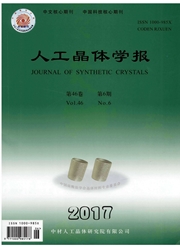

 中文摘要:
中文摘要:
分别通过VLS和VS生长机制得到了Si3N4纳米线和纳米带。产物经X射线衍射(XRD)、扫描电镜(SEM)、透射电镜(TEM)等表征手段进行了分析。FTIR图谱表明它们在800 -1100cm^-1的波数范围内有一个宽的吸收带,这是Si-N键伸缩振动模式的典型吸收带。它们的室温光致发光图谱显示,在420nm左右都有一很强的发射带,表明其将在纳米光电器件中有潜在应用。另外,Si3N4纳米线发光峰与纳米带的发光相比有少许蓝移(蓝移约4nm),这可能和晶须尺寸的少许差别有关。至于纳米带的发光强度大于纳米线的原因,可能是纳米带的比表面积相对较大,有利于悬键的形成,从而导致材料结构内缺陷的浓度较大。
 英文摘要:
英文摘要:
Single crystalline Si3N4 nanowires and nanobelts have been synthesized by vapor-liquid-solid (VLS) and vapor-solid(VS) mechanism respectively. Their morphologies and microstructures were determined by X-ray diffraction (XRD),scanning electron microscopy (SEM), and transmission electron microscopy (TEM).The FTIR spectra of them show a broad absorption band in the range of 800-1100cm^-1 which corresponded to the stretching vibration absorption peaks of the Si-N. Photoluminescence (PL) measurements of them under excitation at 280nm at room temperature show a broad blue emission band at about 420nm, suggesting their potential applications in light emission nanodevices. In addition, the peak position of Si3N4 nanowires had blue shift according to the peaks of Si3N4 nanobelts, which might be related to the dimension difference between them. The results also show the PL intensity of the nanobelts was stronger than that of nanowires which might be resulted from the different defect concentrations.
 同期刊论文项目
同期刊论文项目
 同项目期刊论文
同项目期刊论文
 期刊信息
期刊信息
